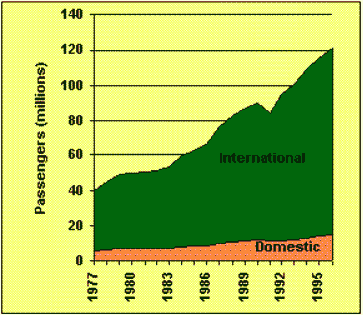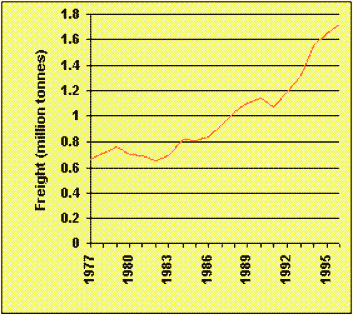| Something about Planes | |
|
|
 |
Whilst this is not a subject we will cover in depth it is worth reviewing briefly the increasing use of aviation. Figure 7 shows the figures for the UK market for passenger travel. Although domestic travel has increased, it is far outweighed by the increase in international travel. In addition more freight also travels by plane as shown in figure 8. |
| Figure 7 Passenger travel by air - 1977-1996 | |
Aviation and the Environment
|
|
 |
|
| Figure 8 Use of aviation for freight transport in the UK | |
 The US space shuttle releases approximately 265 tons of hydrochloric acid into the atmosphere per launch. The average number of shuttle runs annually is 10, and it has been estimated that these shuttles alone could cause a 10% depletion in the ozone layer by 2010. The chlorine in the hydrogen chloride gas can react with ozone in much the same way that the chlorine from CFC's in aerosols.
The US space shuttle releases approximately 265 tons of hydrochloric acid into the atmosphere per launch. The average number of shuttle runs annually is 10, and it has been estimated that these shuttles alone could cause a 10% depletion in the ozone layer by 2010. The chlorine in the hydrogen chloride gas can react with ozone in much the same way that the chlorine from CFC's in aerosols.
|
|
| Task 2: How many trees should you plant this year? | |
|
As a rough estimate, 1 gallon of fuel produces 20lbs of CO2, which is equivalent to 1/50th of a tree, i.e. if you use 50 gallons you need one tree to absorb the CO2 produced by 1 gallon of petrol.
a) Calculate your average petrol use in one week. How many trees does this equal?
|
|
| Need a new spade? | |